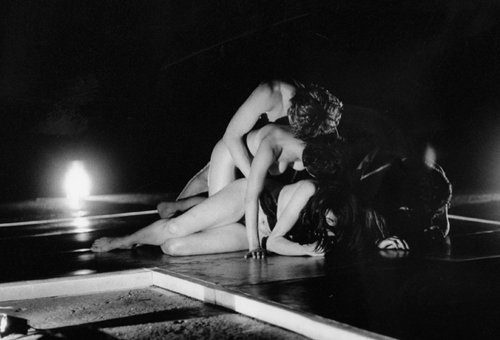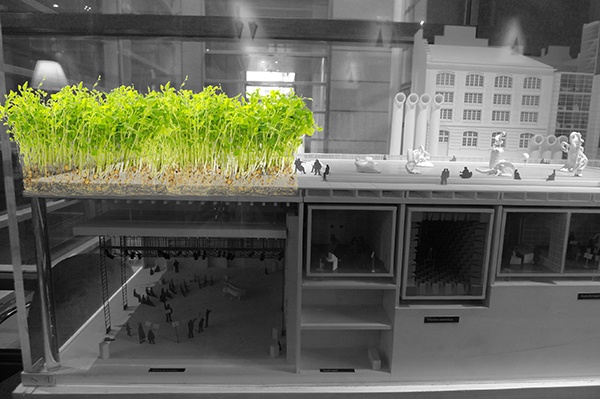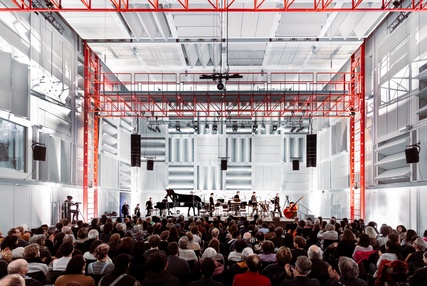1977-2023 : L'Odyssée de l'Espace de Projection [3/3]
Cloisons poreuses pour parois mobiles
 Machinations cristallise en tout cas ce moment qui voit l’Ircam s’ouvrir à des formes scéniques aux frontières malléables et poreuses, et à d’autres disciplines, notamment à travers la création, en 1999, du festival Agora, qui se déploie au-delà de l’Espace de projection. Éric de Visscher le confirme : « La forme festival permettait de sortir d’une logique de saison, de faire entrer tous les champs pluridisciplinaires, d’aller vers d’autres horizons. » Ces horizons, ce sont d’abord ceux de la danse. Près de vingt ans après Béjart, le prodige Boris Charmatz débarque à l’Espace de projection en avril 1999 avec Herses, une lente introduction. Cette pièce de 1997, « quatuor pour cinq danseurs et un violoncelliste sur des musiques de Helmut Lachenmann », frappe par la crudité de son dispositif – des ghetto blasters disséminés, à côté de petites sources de lumière, sur un plateau où évoluent des corps nus. La danseuse Myriam Lebreton en faisait partie : « Ce qui m’a frappée, c’est que dans l’Espro, on jouait dans un espace nu, clair, très différent d’une “boîte noire“ classique. La plaque de fer qui nous servait de scène était posée dans cet espace lui-même clair et métallique et se réverbérait sur le public, et cela créait une proximité, cela rendait le public, disons, plus “acteur”. La pièce prenait tout son sens, j’avais la sensation que c’était exactement là qu’il fallait être… »
Machinations cristallise en tout cas ce moment qui voit l’Ircam s’ouvrir à des formes scéniques aux frontières malléables et poreuses, et à d’autres disciplines, notamment à travers la création, en 1999, du festival Agora, qui se déploie au-delà de l’Espace de projection. Éric de Visscher le confirme : « La forme festival permettait de sortir d’une logique de saison, de faire entrer tous les champs pluridisciplinaires, d’aller vers d’autres horizons. » Ces horizons, ce sont d’abord ceux de la danse. Près de vingt ans après Béjart, le prodige Boris Charmatz débarque à l’Espace de projection en avril 1999 avec Herses, une lente introduction. Cette pièce de 1997, « quatuor pour cinq danseurs et un violoncelliste sur des musiques de Helmut Lachenmann », frappe par la crudité de son dispositif – des ghetto blasters disséminés, à côté de petites sources de lumière, sur un plateau où évoluent des corps nus. La danseuse Myriam Lebreton en faisait partie : « Ce qui m’a frappée, c’est que dans l’Espro, on jouait dans un espace nu, clair, très différent d’une “boîte noire“ classique. La plaque de fer qui nous servait de scène était posée dans cet espace lui-même clair et métallique et se réverbérait sur le public, et cela créait une proximité, cela rendait le public, disons, plus “acteur”. La pièce prenait tout son sens, j’avais la sensation que c’était exactement là qu’il fallait être… »
En 1999 également est créé un pôle chorégraphique, dirigé par François Raffinot, qui, malgré sa fermeture prématurée, aura lui aussi permis d’ouvrir les yeux et les esprits. Mais aussi les cursus, qui deviennent plus interdisciplinaires : on vient à l’Espace de projection pour travailler sur des capteurs de mouvement de plus en plus sophistiqués – on n’a pas oublié, en 2005, la création, au Centre Pompidou voisin, de Double Points+, fascinant corps-à-corps en temps réel entre la musique de Hanspeter Kyrburz et la danse improvisée d’Emio Greco… En 2004, c’est avec l’équipe de l’Ircam et Romain Kronenberg qu’Olivia Grandville ausculte les interactions entre qualités de mouvement et paramètres sonores pour son spectacle Comment taire. L’Espace de projection verra encore passer Mathilde Monnier, Odile Duboc…
Dans le même temps, l’Espace de projection continue d’héberger des recherches acoustiques qui, une nouvelle fois, trouvent des applications marquantes, dopées par l’augmentation exponentielle de la puissance de calcul des ordinateurs. En l’occurrence, les années 2000 sont celles qui voient l’avénement de la WFS (Wave Field Synthesis). Une technologie de pointe permettant, via un anneau regroupant plusieurs centaines de haut-parleurs, de recréer, par exemple, l'illusion parfaite d'une source sonore au centre de la salle et se déplaçant dans le public.. Olivier Warusfel précise : « Le système WFS de l’Espro, c’est un anneau sur les 4 murs, jusqu’à 280 HP collés les uns aux autres. Il est complété par un dôme HOA (High Order Ambisonics) de 75 HP répartis sur les murs et le plafond »




Dispositif de spatialisation sonore multicanal équipant l'Espace de projection et combinant les systèmes WFS et Ambisonics © Centre Pompidou, photo Philippe Migeat
L'association de ces deux systèmes HOA et WFS, conçue par Markus Noisternig pour l'Espace de Projection et leur intégration dans la bibliothèque du Spatialisateur par Thibaut Carpentier forment à la fin des années 2000, l'instrument de spatialisation le plus ambitieux. « L’inauguration de ce dispositif complet a été réalisée avec Natasha Barrett et Rama Gottfried, qui étaient en résidence en 2011, se souvient Olivier Warusfel. Ce fut un grand moment, réunissant l’Ircam, le président de l’université Pierre et Marie Curie, le CNRS, co-financeurs avec la région Ile-de-France… » Il conclut : « Le spatialisateur est le dépositaire de nos savoirs, c’est la matrice. »
Autant d’outils qui inspirent les artistes. En 2014, l’Israélienne Chaya Czernowin recourt ainsi à la WFS pour HIDDEN : une partition pour quatuor à cordes et électronique créée dans le cadre de ManiFeste : initié par Frank Madlener, comme directeur artistique et général de l’Ircam, ce festival, intégrant une académie internationale « pour les arts du temps (musique, danse, théâtre, vidéo, cinéma) et l’invention technologique » est venu en 2012 succéder à Agora. Autant d’outils qui attirent également les interprètes « classiques » – les pianistes Hélène Grimaud et Alexandre Tharaud, notamment – venus mettre à profit les propriétés acoustiques de l’Espace de projection pour des enregistrements. Autant d’outils, enfin, qui essaiment hors les murs : de la Cour d’honneur du Palais des papes d’Avignon à la Chine, nombre de lieux de spectacle se sont équipés du système WFS...
Mais, bien au-delà de la technologie, l’extension du champ des possibles peut prendre une multiplicité de formes. En témoigne par exemple le cas de NetTrike, création du compositeur Bernhard Lang et de la chorégraphe Christine Gaigg donnée en 2010 dans le cadre du programme CO-ME-DIA : deux danseurs y interprètent la même pièce, l’un à l’Espace de projection, l’autre à Graz, sur deux scènes séparées mais synchronisées. Andrew Gerzso en était à l’initiative : « Élargir la notion d’espace : une expérience qui n’avait jamais été tentée. Nous avons créé un grand espace virtuel pour ces deux scènes – et on a même capté des sons du public (mouvements de pieds, toux…), pour accentuer la présence du public et rendre l’événement “en temps réel“. C’était assez compliqué, une bande passante énorme ! Mais le public a marché et ce fut un gros succès… »
 C’est encore le cas avec Germination, en 2013, projet de Jean-Luc Hervé, compositeur féru de jardins japonais et de paysage. Un projet qui ambitionne d’associer l’Ircam et la nature. Serge Lemouton : « Il s’agissait de penser le monde souterrain comme le lieu des racines, de planter des graines qui allaient germer entre les rainures de la place Stravinsky… Cette intervention dans l’espace public était tout à fait inédite pour nous. On a travaillé avec une paysagiste et des apprentis horticulteurs de l’École du Breuil. À la fin de la pièce, le son spatialisé en 3D montait en spirale vers le haut, et on accompagnait les spectateurs vers le jardin de la place voir les plantes qui avaient germé ; parmi elles, on avait placé de petits haut-parleurs, comme si elles avaient brisé le plafond de l’Ircam… » Si l’Espace de projection est tiraillé vers l’extérieur, si ses cloisons semblent devenues de plus en plus poreuses, il l’est aussi vers l’intérieur, grâce une nouvelle fois au trublion Georges Aperghis. En 2011 en effet, celui-ci y crée Luna Park : un spectacle hybride, dérangeant, dans lequel les quatre interprètes sont enfermés dans autant d’étroites cabines métalliques placées côte à côte, comme des cages, munies chacune de quatre caméras et d’un écran. Le thème du spectacle est la vidéosurveillance, « un sujet sérieux, traité de manière originale et finalement assez plaisante, souligne Richard Dubelski, complice de longue date d’Aperghis et interprète de ce Luna Park. Fixés à mes poignets, j’utilisais des capteurs appelés “accéléromètres”, des outils spécialement développés à l’Ircam pour ce spectacle, avec le RIM Grégory Beller. Quand je bougeais la main, cela déclenchait des séquences sonores préenregistrées : voix, sons de flûte… Il fallait tout combiner ». Andrew Gerzso est enthousiaste : « On voit souvent des pièces avec beaucoup de technologies mais où cela ne fonctionne pas toujours bien. Ici, les différents éléments – vidéo, captation, gestes – créaient une cohérence très convaincante ! » Une nouvelle fois, avec un opus mettant de nouveau la technologie au centre, et en abyme, Georges Aperghis réussissait à déjouer la dialectique du démonstratif et de l’excès de subtilité.
C’est encore le cas avec Germination, en 2013, projet de Jean-Luc Hervé, compositeur féru de jardins japonais et de paysage. Un projet qui ambitionne d’associer l’Ircam et la nature. Serge Lemouton : « Il s’agissait de penser le monde souterrain comme le lieu des racines, de planter des graines qui allaient germer entre les rainures de la place Stravinsky… Cette intervention dans l’espace public était tout à fait inédite pour nous. On a travaillé avec une paysagiste et des apprentis horticulteurs de l’École du Breuil. À la fin de la pièce, le son spatialisé en 3D montait en spirale vers le haut, et on accompagnait les spectateurs vers le jardin de la place voir les plantes qui avaient germé ; parmi elles, on avait placé de petits haut-parleurs, comme si elles avaient brisé le plafond de l’Ircam… » Si l’Espace de projection est tiraillé vers l’extérieur, si ses cloisons semblent devenues de plus en plus poreuses, il l’est aussi vers l’intérieur, grâce une nouvelle fois au trublion Georges Aperghis. En 2011 en effet, celui-ci y crée Luna Park : un spectacle hybride, dérangeant, dans lequel les quatre interprètes sont enfermés dans autant d’étroites cabines métalliques placées côte à côte, comme des cages, munies chacune de quatre caméras et d’un écran. Le thème du spectacle est la vidéosurveillance, « un sujet sérieux, traité de manière originale et finalement assez plaisante, souligne Richard Dubelski, complice de longue date d’Aperghis et interprète de ce Luna Park. Fixés à mes poignets, j’utilisais des capteurs appelés “accéléromètres”, des outils spécialement développés à l’Ircam pour ce spectacle, avec le RIM Grégory Beller. Quand je bougeais la main, cela déclenchait des séquences sonores préenregistrées : voix, sons de flûte… Il fallait tout combiner ». Andrew Gerzso est enthousiaste : « On voit souvent des pièces avec beaucoup de technologies mais où cela ne fonctionne pas toujours bien. Ici, les différents éléments – vidéo, captation, gestes – créaient une cohérence très convaincante ! » Une nouvelle fois, avec un opus mettant de nouveau la technologie au centre, et en abyme, Georges Aperghis réussissait à déjouer la dialectique du démonstratif et de l’excès de subtilité.


Luna Park de Georges Aperghis © Ircam-Centre Pompidou
Le 13 janvier 2014, la création d’Isis und Osiris de Jacques Lenot est le dernier concert accueilli à l’Espace de projection avant fermeture. Un concert, ou plutôt une « installation sonore mixte pour septuor à vent et environnement électronique », d’après un poème de Robert Musil, qui constitue l’une des premières incursions dans l’électronique de ce compositeur de bientôt 70 ans. Serge Lemouton dit avoir eu l’impression d’assister à une « messe de la Renaissance » : « Jacques Lenot est venu à l’Ircam, dans l’Espro, avec l’idée d’utiliser la verticalité du lieu. À cette époque, on avait déjà le dôme ambisonique, les 350 HP… Les spectateurs étaient au centre, les 7 musiciens étaient disposés autour du public et il y avait une diffusion spatiale placée derrière. C’était une pièce d’une heure, d’une écriture très polyphonique, spatialisée avec différentes sources électroniques. Une expérience forte. » Avec laquelle fermait ses portes pour près de dix ans un espace qui, comme le souligne Andrew Gerzso, aura su réunir, au-delà des mordus de la musique contemporaine, « un public qui cherchait des expériences différentes ». Serge Lemouton opine : « Les gens s’imaginent un lieu très fermé, rigide, mais moi je n’ai jamais fait deux fois le même spectacle ! C’était très créatif, les compositeurs inventaient en fonction du lieu, on ne se limitait jamais aux moyens que l’on avait, on essayait toujours de se dépasser… »
Cette permanence de l’utopie devrait sans doute continuer à guider l’esprit de l’Espace de projection, qui vient de rouvrir ses portes en janvier 2023 avec six jours de « fête ». Quelle utopie artistique et/ou technologique l’Espace de projection a-t-il désormais à porter ? Et quel rôle a-t-il à jouer, au moment où la dimension « immersive » semble devenir un prérequis indispensable ? « L’Espro est un lieu unique à Paris, conclut Frank Madlener : un espace des possibles et des premières fois, moins une salle qu’un instrument, qui offre aux artistes et aux scientifiques ce qui leur manque le plus : du temps d’expérimentation et de production. “Nulle part ailleurs”, cela s’adresse aussi aux spectateurs. Pourquoi sortir de chez soi aujourd’hui, avec l’accès théorique de tout à tous, par le numérique ? Pourquoi sortir, sauf pour faire une expérience hors du commun ! L’Espro, qui consonne avec l’Esprit du temps, se dédiera à la création et au répertoire, qui est la création plus la vie ; à l’écriture musicale et aux musiques électroniques exploratoires ; aux installations, aux fictions sonores, au spectacle vivant comme à la science participative. On y vivra la musique, assis, debout ou couchés, comme lors de la reconstitution du Polytope de Xenakis ; il y aura de la convivialité, des bords et des bars de plateau. L’utopie est double. Prototyper pour transposer partout ensuite. Ne plus pouvoir reconnaître chaque spectateur du contemporain, car un nouveau public aura été mobilisé et séduit par le plaisir d’habiter la création au présent. »
par Sandrine Maricot Despretz et David Sanson (Hémisphère son)
Photo 1 : Herse, une lente introduction © Jean-Michel Cima, Le Quartz, Brest, France, 1997
Photo 6 : Maquette du projet Germination de Jean-Luc Hervé et Astrid Verspieren




